Today in History: September 12
Saint-Mihiel Offensive

The Town Square of St. Mihiel, France,
Schutz Group Photographers,
1918.
Taking the Long View: Panoramic Photographs, 1851-1991
On September 12, 1918, the American Expeditionary Forces under commander in chief General John J. Pershing launched their first major offensive in Europe as an independent army. General Pershing had placed the first American troops to land in Europe completely at the disposal of Marshall Ferdinand Foch, commander in chief of the French forces. Foch required immediate reinforcement of his troops in the Aisne-Marne region to halt the German Army's move towards Paris.
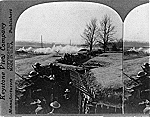
"Over the Top"; American Soldiers Answering the Bugle Call to "Charge,"
March 25, 1918.
Prints and Photographs Division
The American troops fought in the trenches alongside the fatigued French forces at the Battle of Belleau Wood and the Second Battle of the Marne. Once the allied French and American forces had succeeded in halting the German advance in the Aisne-Marne area, Foch and Pershing agreed that the First U.S. Army would establish a headquarters in the Saint-Mihiel sector. The German Army had occupied the area in fall 1914, and fortified the triangular wedge between Verdun and Nancy known as the Saint-Mihiel salient, effectively preventing rail transport between Paris and the Eastern Front.
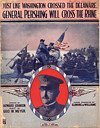
"Just Like Washington Crossed the Delaware, General Pershing Will Cross the Rhine,"
Howard Johnson, words,
George W. Meyer, music,
1918.
Historic American Sheet Music, 1850-1920
On August 13, 1918, the U.S. First Army established a separate front facing the Saint-Mihiel salient to prepare for the long-planned assault, intending to make a push through Metz across the Rhine River into Germany. Pershing hoped to bring the war to an end in 1919, but he did not expect to defeat the German Army as early as November.
In planning the assault, the United States military had a new weapon, the armored tank. General Pershing created the U.S. Tank Corps, committed for use in support of the Infantry, under the command of the brilliant and aggressive young lieutenant, George S. Patton. Patton had been training the tank brigades throughout the summer of 1918. In the St. Mihiel offensive, the American Expeditionary Forces utilized with resounding success the armored fighting tank brigades as a substitute for the cavalry.
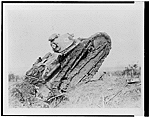
Tank Ploughing Its Way Through a Trench and Starting Toward the German Line,
During World War I, Near Saint Michel, France,
1918.
On September 12, 1918, the tanks began to move forward, ploughing over the trenches, with the infantry close behind. The bad weather which followed in the next few days proved a more formidable enemy than the German Army. Torrents of rain turned the fields to mud and the trenches to water-filled ditches. A number of tanks were stuck.
The Germans turned the situation to their advantage by creating more "water tank traps" to stop the advance. In spite of these adverse conditions, the First Army's attack on both faces of the salient succeeded. By September 16, 1918, this area of France was liberated from German occupation.
Following the successful purging of the Saint-Mihiel salient, the American forces shifted to a new front to participate in the Meuse-Argonne offensive, again using the U.S. Tank Corps. The combined Allied offensive successfully forced the German retreat. By October, the defeat of the German Army was certain. The "Great War" came to an end with the signing of the Armistice on November 11, 1918.

Fresnes-en-Woevre, in the St. Mihiel Sector Where Terrific Fighting Took Place
Schutz Group Photographers,
1918.
Taking the Long View: Panoramic Photographs, 1851-1991
The Americans who participated in the liberation of France were deeply shocked to see the devastation suffered by the French civilians, who had lost their homes, their livelihood, and their lives during the war. The compassion of the soldiers of the American Expeditionary Forces for the French people generated many popular songs such as the example shown below, "The Tale the Church Bell Told."
In the shattered part of France,
In the very heart of France,
A soldier from a Yankee shore,
Lay dreaming by an old church door,
From the belfry in the sky,
He thought he heard the old bell sigh:
I was lonely in the steeple,
How I missed the birds of spring,
Looking down upon my people,
It just broke my heart to ring,
Through the din of cannon thunder,
I could hear the cries of young and old,
Someone will answer for this violence,
Answer for my silence,
That's the tale the church bell tolled.
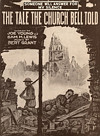
"The Tale the Church Bell Told; Someone Will Answer For My Silence"
Bert Grant, music,
Joe Young and Sam M. Lewis, words,
1918.
Historic American Sheet Music: 1850-1920
Learn more about World War I in American Memory:
- Search the collection Taking the Long View: Panoramic Photographs, 1851-1991 on World War to retrieve over one hundred panoramic photographs of battlefields and military life. Search on St Mihiel to retrieve a number of photographs, several of which are actually dated September 12, 1918.
- Search on tank or armored vehicle in the following collections to see photographs of the first generation of armored fighting vehicles, both with and without the caterpillar traction which permitted them to get over the muddy trenches of the French battlefields:
- Search on World War in Historic American Sheet Music: 1850-1920 to find over one hundred pieces from the period of the First World War, including George M. Cohan's "Over There" and "It's a Long Way to Tipperary." Cover illustrations and song lyrics contribute valuable information to our understanding of the popular culture of that time, with themes ranging from politics and patriotism, to racial stereotypes, to sentiments about home and family.
- Search the American Memory Collection of sound recordings to listen to some of the songs sung by the soldiers of the American Expeditionary Forces. For example, don't miss "Madelon ("I'll Be True to the Whole Regiment")," "It's a Long Way Back to Tipperary," and "Over There."
- Search on World War in American Life Histories, 1936-1940 to read veterans' stories.
- Search on World War in American Leaders Speak, 1918-1920 to find recordings of speeches on the subject of the First World War. The collection includes a thirty-three-second speech by General John J. Pershing, "From the Battlefields of France" recorded on location. Don't miss World War I: An Introduction, part of the Special Presentation, From War to Normalcy, associated with this collection.
- View films shot during the First World War in the motion picture collections. Examples include films showing members of President Theodore Roosevelt's family who were active in the war effort:
- Search the Today in History Archive on World War I for relevant features on the war, such as the sinking of the Lusitania, the United States' entry into World War I, Armistice (Veterans) Day, and General John J. Pershing, leader of the U.S. forces in Europe.
H.L. Mencken, Critic of the American "Booboisie"
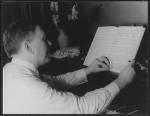
Portrait of H. L. Mencken,
Carl Van Vechten, photographer,
July 1932.
Creative Americans: Portraits by Van Vechten, 1932-1964
Moral certainty is always a sign of cultural inferiority…All human progress, even in morals, has been the work of men who have doubted the current moral values, not of men who have whooped them up and tried to enforce them. The truly civilized man is always skeptical and tolerant…H. L. Mencken,
Minority Report
Writer, editor, philologist, social critic, and Baltimore native H. L. Mencken was born on September 12, 1880. Mencken, who generated a strong literary current in Baltimore during the 1920s and 1930s, was best known for his scathing social commentary, critical support of emerging writers, and for his scholarly understanding of American usage of the English language.
Mencken first reported for the Baltimore Mercury Herald, of which he eventually became editor-in-chief, and later for the Baltimore Sun. During this period, he also wrote for The Free Lance and, then, for a New York monthly magazine, The Smart Set, which he co-edited with the drama critic George Nathan from 1914 to 1923. Mencken left the Smart Set with Nathan and A. A. Knopf to establish the American Mercury in 1924.
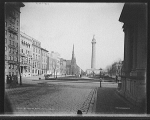
Mt. Vernon Place,
Baltimore, Maryland,
William Henry Jackson, photographer,
1903.
Touring Turn-of-the-Century America, 1880-1920
Literary criticism enjoyed something of a heyday during the first half of the 20th century, and Mencken was one of its most forceful practitioners. His reviews and essays, entitled Prejudices, fill six volumes. Mencken believed a writer's first duty was to present the "unvarnished truth," and he lent critical support to the fiction of Joseph Conrad, Theodore Dreiser, Zona Gale, Sinclair Lewis, Sherwood Anderson, and others.
By the 1930s and 1940s, times had changed, and many found satire to be an inappropriate response to Franklin Roosevelt's New Deal efforts to salvage the economy in the throes of the Great Depression. Many also recognized the gravity of the Nazi threat long before Mencken did. As a consequence, Mencken's influence as a writer declined before his 1956 death.
In 1919, Mencken published his major contribution to philology, The American Language, in which he attempted to analyze the words and phrases, expressions, idioms, and peculiarities of pronunciation and spelling that might be termed "Americanisms." His definitive work was brought out over thirty years in numerous revised and rewritten editions and supplements. This scholarly study, enlivened by Mencken's own particular wit, remains a classic in its field. Mencken's entry on "Americanism," written for the Thirteenth Edition of the Encyclopaedia Britannica published in 1926, typifies the subtle style with which he lampooned both British pretension and, what he termed, American "booboisie":
Americanism, a term first used by John Witherspoon, president of Princeton University, in 1781, designates (a) any word or combination of words which taken into the English language in the United States, has not gained acceptance in England, or, if accepted, has retained its sense of foreignness; and (b) any word or combination of words which, becoming archaic in England, has continued in good usage in the United States…Such words as hominy, moccasin, pone, tapioca and succotash remain everyday Americanisms.
The archaisms, of course, showed themselves more slowly. They had to go out of use in England before their survival in America was noticeable. But by the beginning of the 18th century there was already a considerable body of them, and all through that century they increased. The English language in Great Britain, chiefly under the influence of pedantry in the age of Anne, was changing rapidly, but in America it was holding to its old forms.H. L. Mencken,
"Americanism"
Encyclopaedia Britannica,
Thirteenth Edition, 1926
- To see images of notable people and places from the era in which H. L. Mencken wrote, search the following collections:
- Search the Today in History Archive on writer, playwright or poet to find numerous features on America's literary lights such as William Faulkner, Ernest Hemingway, Langston Hughes, Marjorie Kinnan Rawlings, Archibald MacLeish, and F. Scott Fitzgerald.
- Read H.L. Mencken's scathing commentary on the Scopes Trial, quoted in the Today in History feature of May 5th.